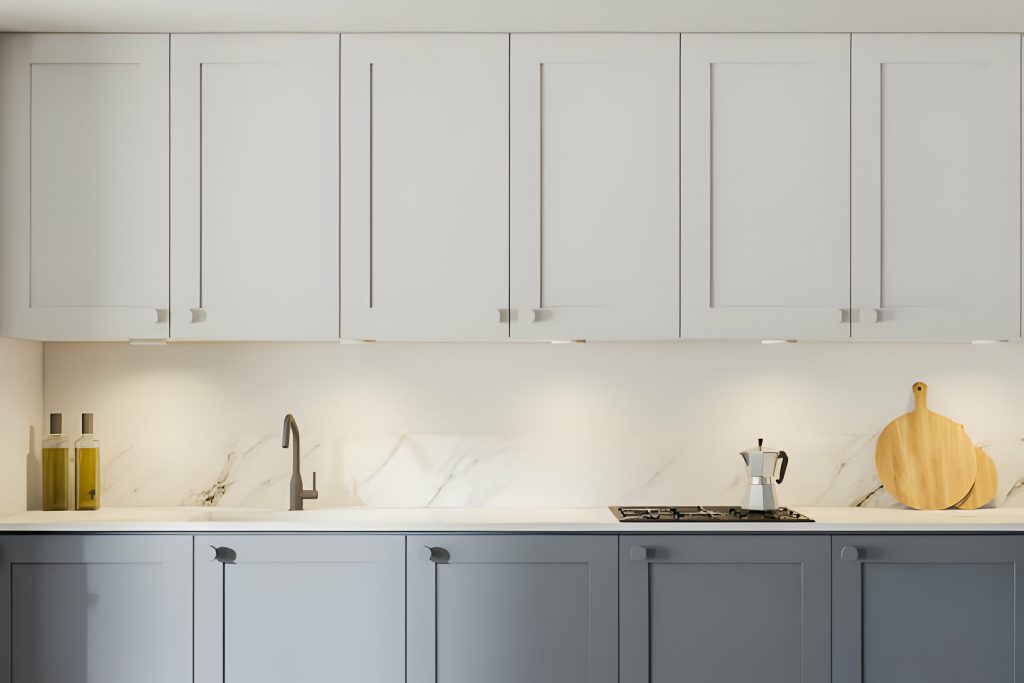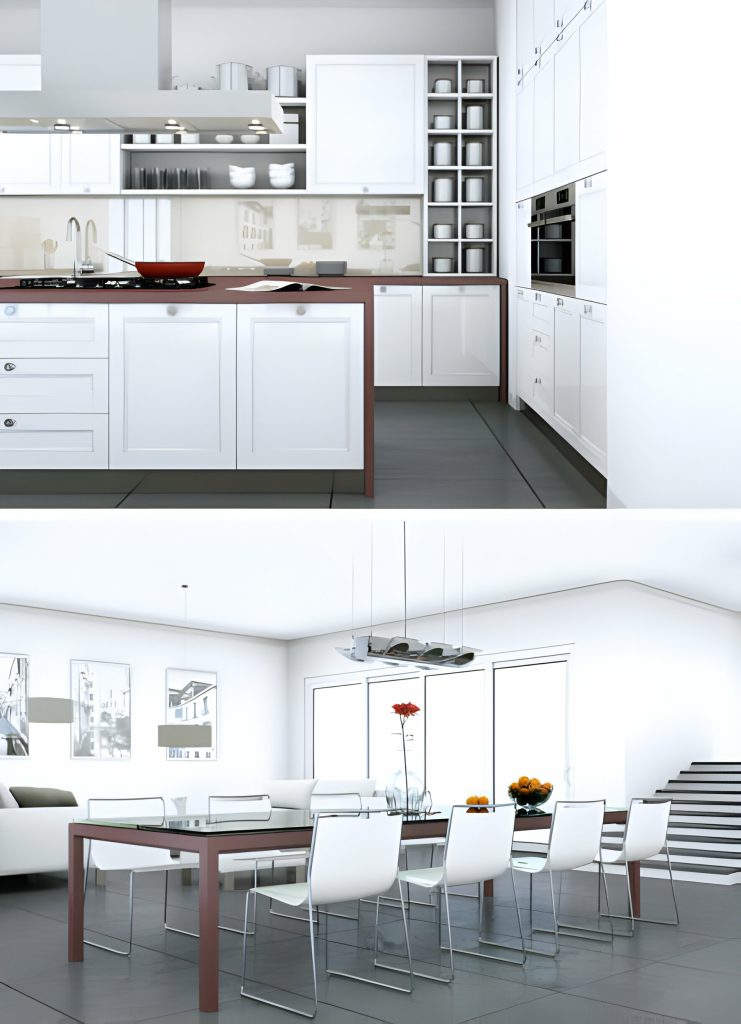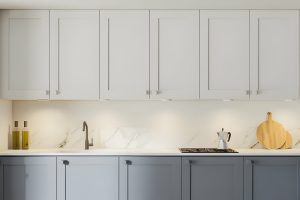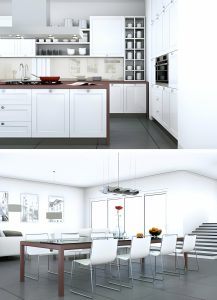If you’re looking to elevate the look of your kitchen, you may be pondering whether raised panel cabinets come with a higher price tag. The cost disparity between raised panel and flat panel cabinets can be influenced by various factors. From the quality of materials utilized to the intricacy of the craftsmanship involved, there are essential aspects to consider. As you explore the nuances of raised panel cabinets, you’ll gain insights into the value they can bring to your kitchen space.
Raised Panel Vs. Recessed Panel Cabinets
When deciding between raised panel and recessed panel cabinets for your kitchen, consider the distinct design elements and functionality each style offers to make an informed choice. Raised panel cabinets feature a raised center panel within a frame, providing depth and dimension to your kitchen. They are available in various styles, from traditional to contemporary, making them suitable for different design preferences. On the other hand, recessed panel cabinets have a sleek appearance with a center panel that is recessed, perfect for modern and contemporary-style kitchens. In terms of maintenance requirements, raised panel cabinets with their intricate detailing may require more effort to clean compared to the flat surfaces of recessed panel cabinets. When it comes to customization options, raised panel cabinets offer more opportunities for personalization, but they come at a higher cost. Additionally, raised panel cabinets are known for their durability, making them suitable for high-traffic kitchen areas, while recessed panel cabinets may have less storage space but are easier to clean due to their smooth surfaces. Ultimately, your choice should be based on the style you prefer, the maintenance level you are comfortable with, and your budget constraints.
Factors Influencing Cabinet Pricing
To understand the varying costs associated with cabinet options, it is essential to analyze the specific factors that influence pricing in the cabinet industry. Several key elements affect the overall pricing of cabinets, including cabinet door materials, customization options, installation costs, maintenance requirements, and resale value considerations.
Consider the table below for a comprehensive breakdown of these influencing factors:
| Factors | Description |
|---|---|
| Cabinet Door Materials | The type of material used for the cabinet doors significantly impacts the overall cost. |
| Customization Options | The level of customization, such as unique finishes or intricate designs, can increase prices. |
| Installation Costs | Professional installation services may add to the total cost of the cabinets. |
| Maintenance Requirements | Some materials require more upkeep, which can affect long-term maintenance costs. |
| Resale Value Considerations | Higher-quality materials and craftsmanship can enhance the resale value of cabinets. |
Understanding these factors can help you make informed decisions when selecting cabinets that align with your budget and preferences.
Cost Considerations for Cabinet Doors
Considering the cost implications of different cabinet door options is crucial when planning your kitchen renovation or upgrade project. Raised panel cabinet doors, with their intricate designs and classic appeal, often come at a higher cost compared to flat panel doors. While flat panel doors provide a sleek and modern aesthetic at a more budget-friendly price point, raised panel doors offer a timeless look that adds depth and sophistication to your kitchen.
When evaluating the cost of cabinet doors, it’s essential to factor in design trends, installation process, maintenance requirements, customization options, and resale value. Raised panel doors, being more traditional and customizable, may enhance the resale value of your home but require higher maintenance due to their detailed areas. Conversely, flat panel doors are easier to maintain and may suit modern design trends, making them a practical choice for those looking for a more cost-effective option without compromising on style.
Material Impact on Cabinet Costs
Explore how the choice of materials impacts the overall cost of cabinet doors, influencing the budget and aesthetic appeal of your kitchen renovation project.
- Material Comparison
- Different materials like solid wood, wood veneer, MDF, or laminate affect costs.
- Cost Analysis
- Solid wood is typically more expensive than MDF or laminate.
- Wood veneer offers a balance between cost and quality.
- Style Impact
- Solid wood provides a luxurious and classic look.
- MDF and laminate offer versatility and cost-effectiveness.
- Budget Planning
- Consider long-term investment when choosing materials.
When comparing materials, solid wood stands out for its durability and high-end appearance, making it a long-term investment. However, if budget constraints are a concern, MDF or laminate can provide a similar aesthetic appeal at a lower cost. Your choice of material should align with your desired kitchen style and budget, ensuring a harmonious blend of quality and affordability for your cabinetry needs.
Design Aesthetics and Price Differences
When selecting between raised panel and recessed panel cabinet doors, the design aesthetics and price differences play a crucial role in determining the overall look and cost of your kitchen renovation project. Raised panel doors are known for their classic, timeless look and durability, offering a sense of opulence and refinement that can make a bold statement in your kitchen. On the other hand, recessed panel doors provide a sleek, modern appearance and are typically less expensive and easier to maintain. Your style preferences, such as whether you lean towards traditional or contemporary designs, will heavily influence your decision. Consider the design impact each door style will have on your kitchen space, balancing the aesthetic appeal with your budget constraints. Ultimately, conducting a cost analysis based on the overall look you want to achieve and the maintenance level you are comfortable with is key to making the right choice for your cabinet renovation project.
Budgeting for Cabinet Renovations
To effectively manage your budget for cabinet renovations, it is crucial to analyze the cost implications of your preferred cabinet door style, whether raised panel or recessed panel, as it significantly impacts the overall expenses of your kitchen project.
- Renovation savings: Consider the long-term savings that come with durable and low-maintenance cabinet door options.
- Budget planning: Plan your budget meticulously, accounting for not just the initial costs but also the potential expenses in the future.
- Expensive choices: Understand that certain design choices, like raised panel cabinets, may be more expensive upfront but offer lasting quality.
- Cost effective options: Explore cost-effective alternatives that meet your aesthetic preferences without breaking the bank.
When budgeting for cabinet renovations, remember that upfront costs are just one part of the equation. Consider the long-term value and durability of your chosen cabinet style to make a cost-effective decision that aligns with your budget and renovation goals.
Long-Term Value of Cabinet Choices
Considering the long-term durability and value of your cabinet choices is essential when planning for your kitchen renovation project. When comparing raised panel cabinets to flat panel cabinets, several key factors come into play. Raised panel cabinets, known for their classic and timeless look, offer superior cabinet durability due to their sturdy construction, typically made of solid wood or wood veneer. While flat panel cabinets are easier to maintain and less expensive upfront, they may lack the longevity benefits that raised panel cabinets provide. The design impact of raised panel cabinets is significant, adding depth and sophistication to your kitchen space. Although raised panel cabinets come at a higher cost initially, their investment value over time, in terms of durability and aesthetic appeal, may outweigh the initial expense. When making your decision, consider the long-term benefits, such as durability, design impact, cost comparison, and investment value, to ensure your cabinet choices stand the test of time.
Making Informed Cabinet Decisions
Making informed cabinet decisions involves evaluating the unique characteristics of your kitchen space and understanding how different cabinet styles can enhance both the aesthetics and functionality of the room. When deciding on cabinet styles, you should consider various factors such as pricing, design choices, material costs, and renovation budgeting.
- Cabinet Styles: Explore options like raised panel and flat panel doors to match your kitchen’s style.
- Pricing Factors: Compare the costs of different cabinet styles to stay within your renovation budget.
- Design Choices: Select a style that complements your kitchen’s overall aesthetic and design concept.
- Material Costs: Consider the materials used in the cabinets as they can impact both the cost and quality of the final product.





